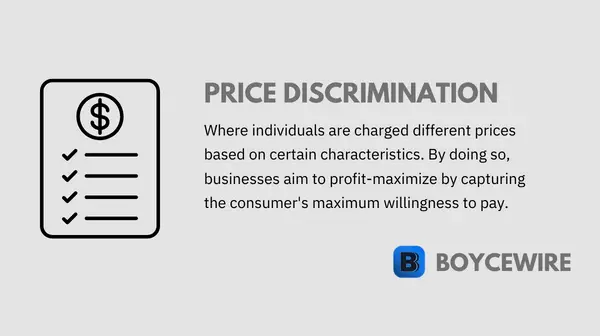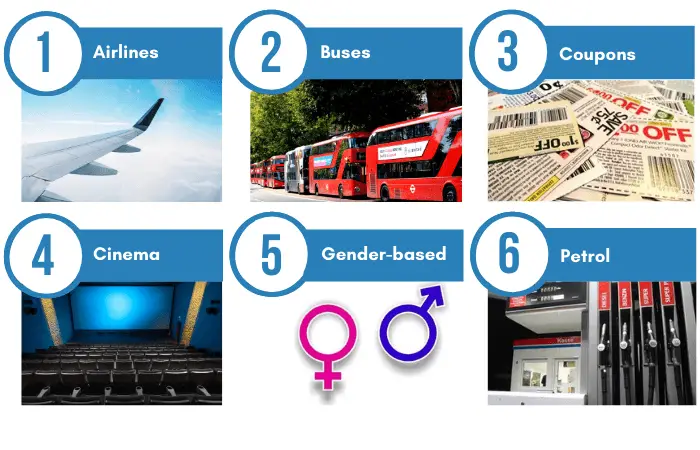Price Discrimination: Definition & Examples

What is Price Discrimination
Price Discrimination is a strategy that businesses use to maximise revenue by charging customers different prices based on their willingness to pay. For example, cinemas frequently offer different prices for adults, seniors, and children. They also offer deals for specific days of the week. This is because movie theatres understand that specific age groups are willing to spend different amounts.
Adults for example have higher levels of incomes than children or seniors. They have work during the week, so are more likely to go on the weekend. This, therefore, gives movie theatres the incentive to price weekends higher because they know adults are willing and able to pay more.
Key Points
- Price discrimination is where the firm charges customers different prices in order to maximise revenue by extracting the maximumin willingness to pay.
- There are three types of price discrimination: first degree, second degree, and third degree.
- In order to engage in price discrimination, the market and good must have identifiable segments, preventable resale, and market power to set prices.
The idea of price discrimination is to maximise revenues by charging each customer their maximum willingness to pay. This way, the firm is able to get the custom and earn a profit at the same time. Usually, it occurs in industries that have low marginal costs. In other words, they can still make a profit by charging a lower price to certain groups.
Price Discrimination Examples
Price discrimination is where a company charges a different price to different groups of consumers. Examples include airlines, buses, cinemas, coupons, petrol, and nightclubs.

Airlines
The airline industry is a classic example of price discrimination. They charge higher prices to last-minute consumers who are desperate to get the last seat. By contrast, consumers who book months in advance benefit from lower prices. Not only does the airline benefit from the cash payment upfront, but also from the certainty that their seats will get filled.
Buses
In most countries, children and senior citizens either receive bus journeys for free or at a discounted rate.
Coupons
Generally sent out to increase purchasing and encourage more price sensitive customers. With the amount of data available in today’s age, supermarkets can accurately price discriminate by sending coupons to expecting mothers, or new home owners.
Cinema
The cinema is another classic example of price discrimination that has been around for years. Adults get charged the highest, with seniors and children receiving lower rates. In addition, some cinemas offer 2 for 1 deals on certain mid-week days to attract more price sensitive consumers to come during non-peak hours.
Gender-based
Clubs often offer ‘ladies night’ or ladies get half price drinks.
Petrol
Some stations offer discounts on specific days. In the UK for example, these discounts are not advertised. However, price sensitive consumers pick up on this and purchase accordingly.
Real Life Example of Price Discrimination
Price Discrimination aims to bring more people into the market. So let us take an example. There are two customers – Mr Jones and Miss Ryan. They both do their weekly shop at the local supermarket.
Mr Jones is willing to pay $60 a week, whilst Miss Ryan is willing to pay even less at $50 a week. They both buy the same goods, but Miss Ryan has a tighter budget.
The supermarket knows that if it keeps the price at $60, Miss Ryan will go elsewhere. Their profit would therefore only be $60. It could reduce the price down to $50; satisfying both customers. This would earn the store $100 in total. However, it could earn even more.
“Businesses charge customers different prices based on the maximum they think a customer is willing to pay.”
If it keeps prices at $60, it still maximises its revenue from Mr. Jones. As a result, Miss Ryan is left out of the market but can be brought back in through a $10 coupon. By offering a voucher, the store is still able to earn $60 from Mr. Jones, but also $50 from Miss Ryan; equalling a total of $110.
Why do Companies Practise Price Discrimination?
Businesses can use price discrimination to effectively extract maximum levels of revenue from consumers. They do this by offering consumers lower prices than they would otherwise be willing to pay. Therefore, consumers who would otherwise be left out of the market are able to participate.
It is easy to look at Price Discrimination and think it’s just businesses trying to make as much money as possible. In essence, this is correct. However, we can actually see positive social effects from such. Low-income consumers can go out for a half-price meal in the week, or get a cheap last minute holiday deal.
In short, Price Discrimination can open up the market to people of all incomes. That doesn’t mean it always does though!
Aims of Price Discrimination
Companies practice Price Discrimination primarily to maximise revenue. In turn, this can also boost underlying profits. However, whilst profit is generally the main goal, it is not the only one.
1. User Experience
Some businesses use Price Discrimination to help enhance the user experience. For example, holiday excursions may offer favorable prices to more price-sensitive consumers who compare online. The result is that the company has a full coach for their tour, but can also enhance the group experience.

We can take restaurants as another example. More customers can create a positive psychological impact. If the restaurant is packed, it shows us that is is popular, which can potentially influence our perception. In turn, it can help to bring in extra customers; even if those specific consumers bring in no profit.
2. Use Spare Capacity
Some businesses have fixed costs. That is to say, they have a specific cost to create a product or service whether they serve one customer or one hundred. Cinemas, for example, have the cost of showing the film. They have this cost whether one person buys a ticket or they fill out the theatre.
If the Cinema only sells tickets at $15 to adults, it may only fill out half the theatre. It still has the capacity to make more sales. The solution, therefore, lies in offering cheaper prices to more price-sensitive consumers.
3. Improve Cash Flow and Improved Planning
For industries such as commercial airlines, cash flow, and future planning can be crucial. Most often, they offer lower prices if you book in advance. Generally, these get sold to the customers who are most responsive to prices.
Those who book last-minute will generally see higher prices as airlines know these customers pay more. However, if the airline still has many seats left, it may in fact reduce prices to encourage demand.
Airlines benefit two-fold from this kind of discrimination. First of all, it allows them to plan their flights better. On occasion, flights may not have enough demand. They can respond by offering cheap last minute deals, or increase prices when they near full capacity
Second of all, it gives airlines the cash upfront. This benefits airlines because it allows them to invest in various ways. They may reduce debt, or invest in new capital equipment.
4. Improve Brand Awareness
Many firms will offer lower prices to certain consumers as it can in fact attract them to their product. Those who are more price sensitive may not have tried the product without it being offered at a lower price – perhaps through a coupon.
However, once they have tried the product, they may very well be willing to spend a higher price next time. At that point, there are no further coupons available and the consumer carries on buying at the higher price.
Necessary Conditions for Price Discrimination
Price Discrimination cannot occur in any industry under any circumstance. There are a number of variables that need to be met in order for businesses to effectively Price Discriminate. We can classify these as follows:
Identifiable Market Segments
The firm must be able to identify different groups that are willing to pay different prices. For example, many firms offer student discounts because they know they aren’t willing to pay the same type of money.
Preventable Re-sale
Firms must be able to prevent consumers who purchase at a lower price from being able to sell to groups that are willing to pay more. For example, ID is generally required in cinemas to prevent adults from obtaining children’s tickets. If adults are able to purchase lower priced child tickets, the effectiveness of price discrimination is lost.
Market Power
Firms must be price makers, not price takers. That is to say, they are able to dictate prices. If they are not, price discrimination won’t be very effective as consumers will be able to go elsewhere.
FAQs on Price Discrimination
There are three main types of price discrimination. They are first degree, second degree, and third degree.
An example of price discrimination is seen at the cinema whereby children and the elderly are charged lower rates than adult tickets.
Firms engage in price discrimination in order to capture excess profit. In other words, they offer lower prices in order to bring in consumers who would otherwise be unwilling to make a purchase.
About Paul
Paul Boyce is an economics editor with over 10 years experience in the industry. Currently working as a consultant within the financial services sector, Paul is the CEO and chief editor of BoyceWire. He has written publications for FEE, the Mises Institute, and many others.

Further Reading
 Illusory Correlation: Definition & Examples - Illusory correlation occurs when we incorrectly believe that two variables have a relationship with each other. The connection between the…
Illusory Correlation: Definition & Examples - Illusory correlation occurs when we incorrectly believe that two variables have a relationship with each other. The connection between the…  Business Ethics - Business ethics refers to the moral principles and values that guide the behavior and decision-making of individuals and organizations in…
Business Ethics - Business ethics refers to the moral principles and values that guide the behavior and decision-making of individuals and organizations in…  Real Interest Rate - Real interest rates are the nominal interest rates adjusted for inflation, representing the true return on an investment after accounting…
Real Interest Rate - Real interest rates are the nominal interest rates adjusted for inflation, representing the true return on an investment after accounting… 